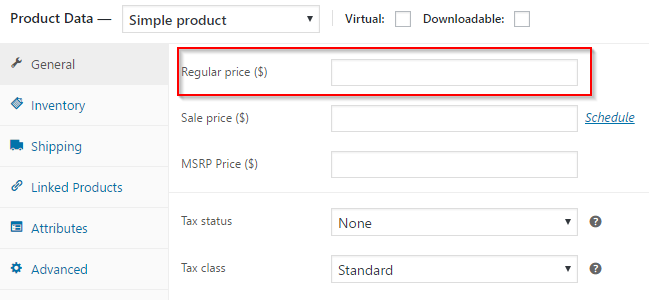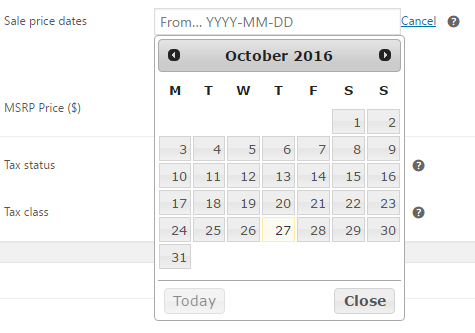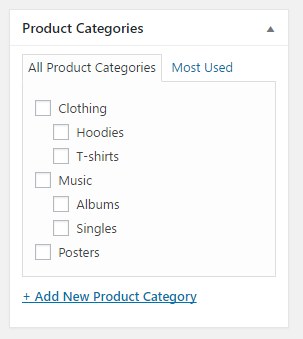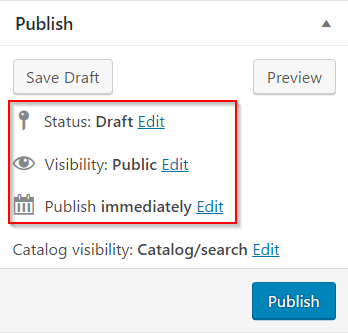Last updated - April 13, 2023
Adding products to WooCommerce is in a lot of ways similar to how you edit a WordPress post. The difference is that Add New Product page has a set of features and attributes corresponding to products instead of posts. To make the process of adding and managing products to your store systematic, WooCommerce classifies products into Simple, Grouped, External/Affiliate and Variable. In addition, there are also Virtual and Downloadable products. This article will focus on adding a ‘simple product’, we will go into the details of other product types later.
On the admin panel, let’s start navigating through the following path:
Products → Add Product


The layout of the page is similar to a WordPress back-end page. Let’s take a quick look at the page features.
You can start by adding a Product name and description for your product. Ideally, writing a paragraph would be good enough for your product description.


On the bottom part of the page, there is a Product Data meta box, where you set up the basic features of your product including product type, price, available stock, dimensions, attributes and stock management.


Now, let’s look into each of these settings in detail.
First, you can choose what type of product you want to add. You can choose from Simple, Grouped, External/Affiliate and Variable.
There are also options to set Virtual and Downloadable products here.


In the General settings, you can set the regular price for your product. Whether your product price is inclusive or exclusive of tax is dependent on what you have chosen in the tax settings.


Discount offers on the product
You can also set a Sale price for your products. The price can be made available for a time period, which you can set by clicking the Schedule link.


You can schedule a sale price by clicking the From… and To… fields and choosing the date from the calendar.


Applying taxes on the product
You can define how you want the tax to be applied to this product – either make the entire product taxable, or just the shipping amount for this particular product.


You can also choose which tax class your product will fall under. you can choose from all the default Standard Rate or one of the additional classes, or your custom-made tax classes.


Product identifier and stock management
In the Inventory settings, you can set up a few options.
You can assign an SKU for your product. SKU or Stock Keeping Unit is a unique identifier that you can assign to the product you are creating.
You can enable stock management at product level by ticking the Manage stock checkbox.
You can edit the Stock status of the product as well. This will update whether your product is in stock or out of stock in the front-end of your store.
Enable Sold individually check box to restrict buying this product more than once in a single order.


Fitting into the shipping framework
Shipping settings allow you to set Weight and Dimensions of your product. Care should be taken to accurately add these features, as any wrong information here may lead to issues with your customer.
You can also assign the product to any of the applicable shipping classes that you have already created.


Creating a link between products
WooCommerce allows linking other products in your inventory with the current product. This is a good marketing strategy for your store.
In the Linked Products settings, you can set three options for this
They are:
- Up-sells – Up-sells are a way of suggesting another similar product to your customer that you assume the customer would like. This is most likely to be a more expensive product as well.
- Cross-sells – These are somewhat related products that you want to suggest to the customer.
- Grouped products – The current product will be set as a part of a grouped product. Grouped products will be covered in detail in another article.


You can add and assign categories for your product in the Categories section.


You can add tags, a featured image and gallery images also from the respective sections.


You can read more about Categories, tags and image settings in the Products Settings article.
Publishing the product
The first three options in the Publish section looks and operates similarly to a WordPress post editor.


There’s a feature in the Publish section that you have to pay attention while organizing your product – Catalog visibility
This will define how this product will be seen in response to searches.
There are four options to choose from:
- Catalog/search – If you choose this option, your product will be displayed everywhere, including category pages, search results and shop page.
- Catalog – Selecting this option will hide your product from search results. It’ll be visible only on category pages and shop page.
- Search – This is the reverse of catalog option. A product will be visible in search results, but not on category pages or shop page.
- Hidden – Choosing this option means the product can only be seen on the single product page; not on any other pages.
You can choose your preferred option and click the OK button.
You can also tick the checkbox to make the product a Featured Product.


After updating all the fields, you can click the publish button.


Checkout the video demonstrating the process of adding a product:
Use Spocket’s US and EU dropshipping marketplace
Alternatively, if you don’t have existing inventory and want to start your store, you can import products from Spocket’s marketplace.
It takes just a few minutes to install Spocket’s plugin, browse products and import them to your store. It is always recommended to optimize your sales copy by writing your own product descriptions and editing the default listings.
You have completed the Quick Guide WooCommerce tutorial. Keep visiting our homepage for more informative articles on WooCommerce.
Related posts:











